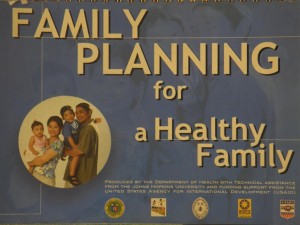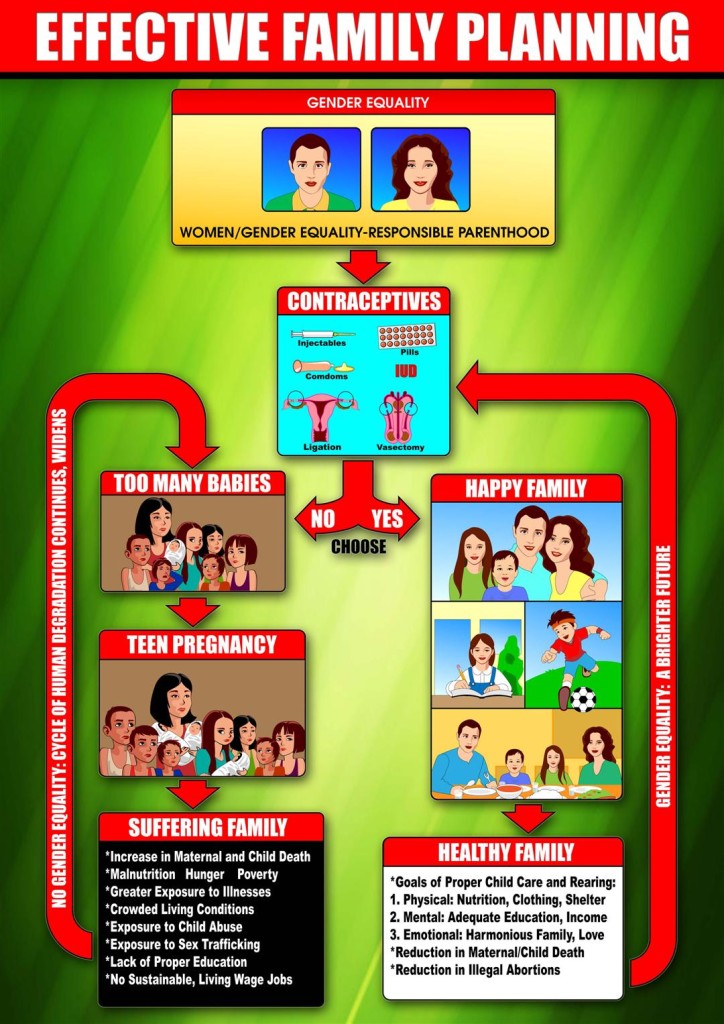Virtually all health professionals agree that the most effective ways to control the population explosion are sex education that should start at a young age along with tubal ligation of women who desire it. Qualifications for ligation of indigent women have recently been revised nationwide from women with four children to women with two children, and the requirement that it needs the husband’s signature approval has been eliminated. Thousands of women in municipalities throughout the country are therefore seeking assistance with ligation.
Increasing the percentage of women of reproductive age who avail themselves of the often tight supply of contraceptives such as pills and injectables and are thereby learning to space their babies are additional ways of effective family planning. While birth control pills are distributed free of charge and are generally available, contraceptive injectables that last for three months have to be purchased by the municipal health centers and provided by midwives with service costs added. This greatly limits their use by indigents as they cannot afford to buy them.
 It is an effective Family Planning Visual Guide book for doctors and nurses produced by the Philippine Department of Health with technical assistance from the John Hopkins University and funding support from the United States Agency for International Development (USAID).
It is an effective Family Planning Visual Guide book for doctors and nurses produced by the Philippine Department of Health with technical assistance from the John Hopkins University and funding support from the United States Agency for International Development (USAID).
I. Family Planning: Having the right number of children born with proper spacing
- Family Planning is helping couples and individuals achieve the desired family size in the context of responsible parenthood.
- Family Planning is spacing pregnancies (2-3 years between pregnancies) to ensure the health of the mother and child.
- Family Planning allows the family members to relate with people in their community.
- Family Planning ensures a healthy family (mother, child and father).
II. Goals of Family Planning:
-
Health of the Mother
A. Family Planning for the mother’s health to enable her to
- regain the strength lost in last pregnancy (women need at least two years to recover their health form the physical stress of pregnancy).
- Avoid, unplanned, high risk pregnancies for mother who are:
– too young (less than 18 years old) or tool old (more than 34 years old)
– having more than four pregnancies
– having closely spaced pregnancies (less than 2 year intervals between pregnancies).
– getting pregnant while sick with chronic diseases like TB, Malaria or with iron deficiency anemia.
Let the woman practice her reproductive right – Millions of women want to stop given birth altogether. Millions of women want to space their pregnancies.
Let the woman devote more and quality time to herself, her children, her husband, the community.
B. Family planning will significantly contribute to the reduction of illegal abortions that lead to complications or even death of the mother.
2. Health of the Child
-
-
Proper child care/rearing
Breast feeding, immunization, proper nutrition, dental care, mental feeding.
-
-
-
Reduction in infant/child deaths in the Philippines through family planning.
Children can be given the proper care, love, and attention to ensure health and survival beyond the age of 5.
-
3. Health of the Family
-
-
Family Planning reduces poverty
*Parents who plan their families are more economically productive
*Budget needs are more easily achieved (compare budget needs of a 4-member family against an 8-member family). -
Family Planning allows both parents to devote more quality time to their children.
-
Family Planning allows the couple more time for each other.
-
III. Health Benefits of Family Planning: relationships.
- Proper child care and rearing
Breast-feeding, immunization, proper nutrition, dental care, mental feeding are important components. - Reduction in infant death in the Philippines through family planning.
IV. Good Health: A healthy body, mind and emotional life
- Physical Health: Having adequate nutrition, clothing, shelter, rest/recreation.
- Mental Health: Having adequate education, sufficient income (self-fulfillment).
- Emotional Health: Having adequate love, care and attention, harmonious family/community
*Children can be given the proper care, love, and attention to ensure health and survival below the age of 5.
V. Family Planning Methods
Choose the family planning method that is right for you.
It is important to get family planning advice from midwives, nurses, doctors.
1. Permanent methods:
Tubal ligation (women)-cutting and tying the fallopian tubes- a procedure for women.
Recommended by doctors as the most effective method for family planning. It is a safe, simple, surgical procedure for women performed by trained health professionals. It requires a small incision in the woman’s abdomen for the fallopian tubes to be cut and tied. With the tubes tied the woman’s egg can not meet the man’s sperm but continues to have her menstrual periods. It generally increases sexual enjoyment because women do not have worry about pregnancy. It has no effect on breast milk, helps protect against ovarian cancer, and does not affect a woman’s ability to perform regular activities.
Many women of financial means have done this procedure. Since it is offered for free for indigents that have Phil Health Insurance women sign up for it provided they have free transportation to and from a clinic as well as family support for the first week after the minor surgery which is not provided by the government or health agencies. If indigents do not have Phil Health Insurance the procedure may cost P2, 000 in addition to support as outlined above.
Vasectomy (men)-cutting and tying the vas deferens.
It is a safe, simple, minor surgical procedure with no side effects. It requires a small incision on the scrotum for the vas deferens to be cut and tied to keep the sperm out of the man’s semen. However, the macho culture in the Philippines is such that virtually no men sign up for such a procedure.
2. Spacing methods
For couples who have reached/achieved the desired family size and no longer wish to have another child.
-
-
DMPA Injectables-An injectable contraceptive that is given every three months. It contains progestin, similar to the natural hormone a woman’s body makes. The progestin is slowly released into the woman’s blood stream.
-
Pills-Oral contraceptive pills contain two hormones similar to a woman’s body-estrogen and progestin/progesterone.
-
Condom-a sheath or covering to fit over a man’s erect penis. Most condoms are made of thin latex rubber and some are coated with lubricants or spermicides.
-
Natural family planning methods-basal body temperature-thermometer, beads.
-
IUD-Usually a small, flexible plastic T-shape device with copper wire. It is inserted into a woman’s uterus through her vagina.
-

